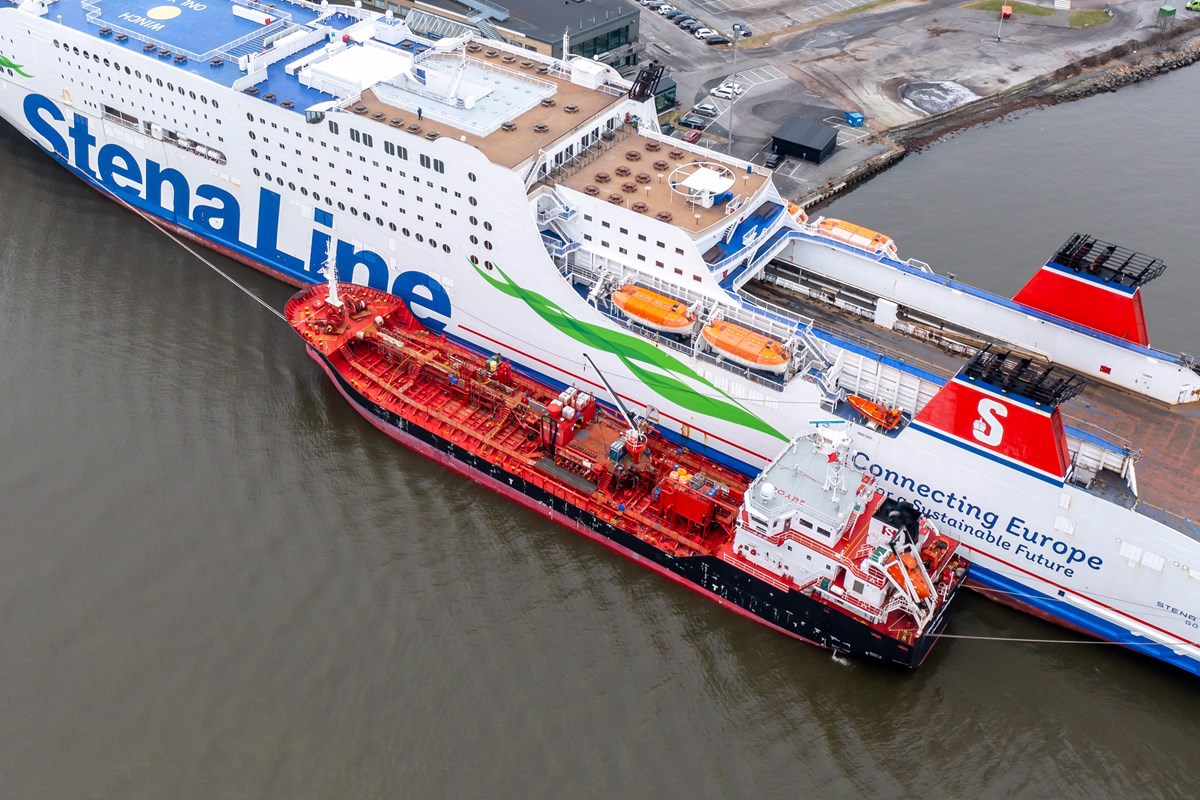Q&A: Port of Gothenburg urges practical measures to boost methanol bunkering
A "pragmatic approach" is required to facilitate methanol bunkering, rather than bunkering regulations and safeguards that raise entry barriers, says Christoffer Lillhage of the Port of Gothenburg.
 PHOTO: First ship-to-ship methanol bunkering of a non-tanker vessel, Stena Germanica, was carried out at the Swedish Port of Gothenburg in January. Port of Gothenburg
PHOTO: First ship-to-ship methanol bunkering of a non-tanker vessel, Stena Germanica, was carried out at the Swedish Port of Gothenburg in January. Port of Gothenburg
The Methanol Institute recently published a report that argued that methanol bunkering from terminals or jetties is "very similar" to marine gasoil or heavy fuel oil bunkering. It can be done with the same bunker infrastructure without major modifications as it doesn't require cryogenic temperatures or compression to stay liquid.
Chemical tankers that carry methanol and other chemicals as cargo is the most common vessel type to also consume methanol as a fuel. The global methanol-capable fleet is now made up of 25 oil and chemical tankers, a RoPax vessel, a tugboat and a pilot boat, according to DNV data.
Methanex's shipping arm Waterfront Shipping operates 19 of these, while the other six are operated by Proman and Stena. These chemical tankers will typically bunker methanol by the chemical plants they load and unload cargo in. Methanex, the world's biggest methanol producer, says methanol is now available in over 125 ports.
Methanol bunkering by barge is relatively a new concept, however, and not many ports have dedicated bunker delivery vessels that can supply methanol to vessels. Bunker delivery operations are instead typically done on a ship-to-ship (STS) basis between chemical tankers and receiving vessels.
With the STS bunkering of the RoPax vessel Stena Germanica in January, the Port of Gothenburg is among the few ports in the world that have implemented methanol bunkering.
To better understand what limitations hinder methanol bunkering from expanding globally, ENGINE spoke with Christoffer Lillhage, senior business development manager at the Port of Gothenburg.
A recent report by the Methanol Institute highlighted that methanol bunkering is “very similar” to marine gasoil or heavy fuel oil bunkering. In this case, what is holding back the expansion of methanol bunkering operations in ports around the world? Is it related to price, availability or logistical constraints?
Currently, there is a limited demand for bunkering operations in ports because of the number of vessels running on methanol. In the coming years, this will change rapidly as methanol vessels enter orderbooks.
We have been bunkering methanol by truck to ship in Gothenburg since 2015, and as highlighted, the first STS of a non-tanker (Stena Germanica) was in January 2023. In Gothenburg, the successful demonstration has been driven by a broad stakeholder collaboration between fuel supplier Methanex, ship owner Stena Line and barge operator E&S and Port of Gothenburg.
We have learned that if we want rapid expansion, we should have a pragmatic approach and not implement bunkering regulations and technical safeguards that create high entry barriers. As such, when implementing new operations, a risk-based approach should be the first priority. A port's responsibility is to facilitate bunkering operations by establishing regulations and clear procedures.
What are the biggest logistical challenges associated with bunkering methanol?
The availability of tank storage and bunker barges for methanol in many ports can be a logistical challenge. However, it is relatively easy to convert existing tank storage and infrastructure [to handle methanol].
Is it more challenging to bunker methanol via an STS transfer than from a terminal?
STS transfers with methanol are carried out on a regular basis around the world. In my view, they are no different from normal STS operations with other cargoes. However, in general, STS operations can be more challenging than operations from the terminal side due to weather conditions and various vessel movements.
The main challenge with methanol bunkering is compatibility between non-tanker vessels and hazardous zones of bunker barges. I don't think it [methanol bunkering] is likely to see a major expansion in the terminal (pipe to jetty) bunkering operations in container, RoRo and cruise segments.
To scale up methanol bunkering operations, a full logistic value chain is needed – including storage, supply and bunker barges. In addition, STS operations must be available in ports during cargo and passenger transits to be time efficient.
The IMO has been urged by some shipping industry organisations to consider market-based measures like a "fund-and-reward" scheme to boost the uptake of bunker fuels with green potential like methanol. Do you think such market-based measures are essential to bridge renewable-fossil fuel price gaps and stimulate wider uptake from ships? And will bunkering infrastructure follow more rapidly if such measures are implemented?
In order to run your vessels on 100% green methanol, you will need to cover the price gap between green methanol and fossil fuels. [Regulations like] Fuel EU and the ETS can help reduce the price gap. In addition, blending green and grey [methanol] molecules will also drastically reduce that price gap. However, it could initially help subsidiaries kick-start a functional market and establish the necessary infrastructure.
By Konica Bhatt
Please get in touch with comments or additional info to news@engine.online





